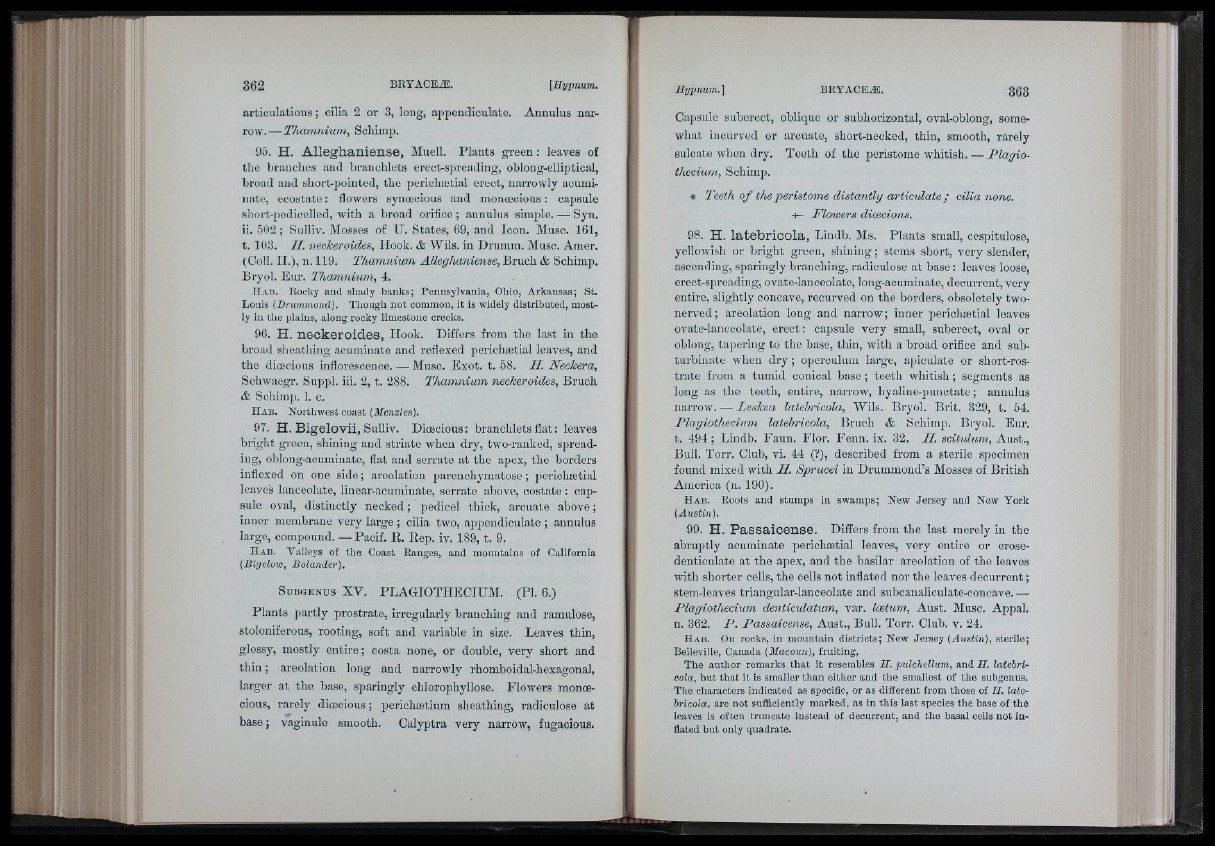
articulations ; cilia 2 or 3, long, appendiculate. Annulus narrow.—
Thamnium, Schimp.
95. H. Alleghaniense, Muell. Plants green : leaves of
tlie branches and branchlets erect-spreading, oblong-elliptical,
broad and short-pointed, the perichætial erect, narrowly acuminate,
ecostate : flowers synoecious and moncecious : capsule
short-pedicelled, with a broad orifice ; annulus simple. — Syn.
ii. 502 ; Sulliv. Mosses of U. States, 69, and Icon. Muse. 161,
t. 103. II. neckeroides, Hook. & Wils. in Drumm. Muso. Amer.
(Coll. II.), n. 119. Thamnium Alleghaniense, Bruch & Schimp.
Bryol. Eur. Thamnium, 4.
H a b . Rocky and shady banks; Pennsylvania, Obio, Arkansas; St.
Louis (Drummond). ïliou g li not common, it is widely distributed, mostly
iu tbe plains, along rocky limestone creeks.
96. H. n eckeroides, Hook. Differs from the last iu the
broad sheatliing acuminate and reflexed perichætial leaves, aud
the dicecious inflorescence. — Muse. Exot. t. 58. H. Neckera,
Schwaegr. Snppl. iii. 2, t. 288. Thamnium neckeroides, Bruch
& Schimp. 1. 0.
H a b . Northwest coast (Menzies).
97. H. Bigelovii, Sulliv. Dicecious: branchlets flat : leaves
bright green, shining and striate when dry, two-ranked, spreading,
oblong-acuminate, flat and serrate at the apex, the borders
inflexed on one side ; areolation parenchymatöse ; perichætial
leaves lanceolate, linear-acuminate, serrate above, costate : capsule
oval, distinctly necked ; pedicel thick, arcuate above ;
inner membrane very large ; cilia two, appendiculate ; annulus
large, compound. — Pacif. R. Rep. iv. 189, t. 9.
H a b . Valleys of tbe Coast Ranges, and mountains of California
(Bigelow, Bolander).
S u b g e n u s XV. PLAGIOTHECIUM. (PI. 6.)
Plants partly prostrate, irregularly branching and ramulose,
stoloniferous, rooting, soft and variable in size. Leaves thin,
glossy, mostly entire; costa none, or double, very short and
thin ; areolation long and narrowly rhomboidal-hexagonal,
larger at the base, sparingly chlorophyllose. Flowers moncecious,
rarely dioecious ; periohætium sheathing, radiculose at
base; vaginule smooth. Calyptra very narrow, fugacious.
Capsule suberect, oblique or subhorizontal, oval-oblong, somewhat
incurved or arcuate, short-necked, thin, smooth, rarely
sulcate wlien dry. Teeth of the peristome whitish. — Plagiothecium,
Schimjj.
* Teeth o f the peristome distantly articulate; cilia none.
H- Flowers dioecious.
98. H. la teb ric o la , Lindb. Ms. Plants small, cespitulose,
yellowish or bright green, shining ; stems short, very slender,
ascending, sparingly branching, radiculose at base : leaves loose,
erect-spreading, ovate-lanceolate, long-acuminate, decurrent, very
entire, slightly concave, recurved on the borders, obsoletely two-
nerved ; areolation long and narrow ; inner perichætial leaves
ovate-lanceolate, erect : capsule very small, suberect, oval or
ohlong, tapering to the base, thin, with a broad orifice and subturbinate
when dry ; operculum large, apiculate or short-rostrate
from a tumid conical base ; teeth whitish ; segments as
long as the teeth, entire, narrow, hyaline-punctate; annulus
narrow. — Leskea latebricola, Wils. Bryol. Brit. 329, t. 54.
Plagiothecium latebricola, Bruch & Schimp. Bryol. Eur.
t. 494 ; Lindb. Faun. Flor. Fenn. ix. 32. II. scitulum, Aust.,
Bull. Torr. Club, vi. 44 (?), described from a sterile specimen
found mixed with II. Sprucei in Drummond’s Mosses of British
America (n. 190).
H a b . Boots and stumps in swamps; New Jersey and New York
(Austin).
99. H. P a ssa ic en se . Differs from the last merely in the
abruptly aouminate perichætial leaves, very entire or erose-
denticulate at the apex, and the basilar areolation of the leaves
with shorter cells, the cells not inflated nor the leaves decurrent ;
stem-leaves triangular-lanceolate and snboanalioulate-ooncave. —
Plagiothecium denticulatum, var. Imtum, Aust. Muso. Appal,
n. 362. P. Passaicense, Aust., Bull. Torr. Club. v. 24.
Ha b . On rocks, in mountain districts; New Jersey (Hiisiin), sterile;
Belleville, Canada (Macoun), fruiting,
The author remarks that it resembles B. pulchellmn, and B. latebricola,
but that it is smaller than either and the smallest of the subgenus.
The characters indicated as specific, or as different from those of B. latebricola,
are not sufficiently marked, as in this last species the base of the
leaves is often truncate instead of decurrent, and the basal cells not inflated
but only quadrate.